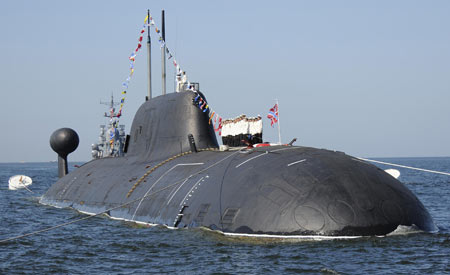Human factors have not yet been identified during an initial investigation of a Russian nuclear submarine accident that claimed 20 military and civilian lives Saturday, local media reported Monday.
 |
|
Russian seamen line up on an unidentified submarine believed to be an Akula-class submarine during a military parade training in Vladivostok in this July 25, 2008 file photo. [Xinhua/Reuters, File Photo] |
"A preliminary probe has shown that the crew had not taken any action. The so-called human factor was not discovered," Interfax news agency quoted Viktor Ishayev, governor of Russia's far eastern Khabarovsk territory.
The tragedy occurred Saturday while the submarine Nerpa was on sea trials in the Sea of Japan. Investigators say a release of freon gas that followed the activation of a fire-extinguishing system is believed to have caused the fatalities.
Three navy officers and 17 members of a shipyard crew were killed in the accident and another 21 people were injured.
There were 208 people aboard the submarine at the time of the accident, including 81 military servicemen.
The last major tragedy on a Russian nuclear submarine occurred on Aug. 12, 2000, when the Kursk sank during a military exercise in the Barents Sea after an explosion ripped through the vessel. All 118 sailors perished.
The latest similar accident involving a Russian submarine was reported in September 2006, when two servicemen were killed and another was injured in a shipboard fire.
(Xinhua News Agency November 11, 2008)